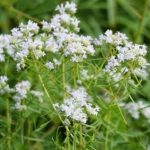 Also called common horsemint and narrow mountain mint, this herbaceous clump-forming perennial is a member of the mint family, Lamiaceae, that also includes rosemary, beebalm, and ajuga. It is native to eastern US from Maine and Wisconsin, south to South Carolina and Texas where it grows in dry and moist soils in prairies, fields, open woodlands, wet thickets, and along streams and roads. Plants grow up to 3′ tall from a taproot with rhizomes and have thin much-branched stems carrying slender leaves up to 3″ long. From mid to late summer terminal flat topped clusters of small white tubular flowers appear. The flowers are 1/4″ long and have two lipped corollas, and are often dotted with purple spots. Various kinds of bees, wasps, flies and butterflies find the flowers attractive but mammals avoid the plants perhaps because of the minty fragrance and taste of all the plant parts. The genus name, Pycnanthemum, comes from the Greek words pyknos meaning dense and anthos meaning flower and refers to the clusters of densely packed flowers. The specific epithet, tenuifolium, comes from the Latin words tenuis meaning slender, and folius meaning leaf and refers to the appearance of the leaves.
Also called common horsemint and narrow mountain mint, this herbaceous clump-forming perennial is a member of the mint family, Lamiaceae, that also includes rosemary, beebalm, and ajuga. It is native to eastern US from Maine and Wisconsin, south to South Carolina and Texas where it grows in dry and moist soils in prairies, fields, open woodlands, wet thickets, and along streams and roads. Plants grow up to 3′ tall from a taproot with rhizomes and have thin much-branched stems carrying slender leaves up to 3″ long. From mid to late summer terminal flat topped clusters of small white tubular flowers appear. The flowers are 1/4″ long and have two lipped corollas, and are often dotted with purple spots. Various kinds of bees, wasps, flies and butterflies find the flowers attractive but mammals avoid the plants perhaps because of the minty fragrance and taste of all the plant parts. The genus name, Pycnanthemum, comes from the Greek words pyknos meaning dense and anthos meaning flower and refers to the clusters of densely packed flowers. The specific epithet, tenuifolium, comes from the Latin words tenuis meaning slender, and folius meaning leaf and refers to the appearance of the leaves.
Type: Herbaceous perennial
Bloom: Clusters of small white flowers from mid to late summer
Size: 1-3′ H x 1-3′ W
Light:Full sun to part shade
Soil:Average, dry to medium, well-drained
Hardiness: Zones 4-8
Care: Low maintenance
Pests and Diseases: None of significance
Propagation: Seed, cuttings in June, division from late fall to early spring
Companion Plants:Stiff goldenrod, sky blue aster, black-eyed Susan, sneezeweed, New England aster, joe-pye weed